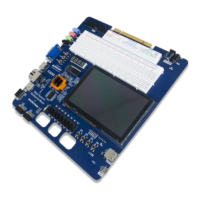44 | ni.com | NI Digital System Development Board User Manual
Program Push Button Switch
The red “PROGB” push button, BTN5, toggles the Zynq’s PROG_B signal. This resets the PL
and causes DONE to be de-asserted. The PL will remain unconfigured until it is reprogrammed
by the processor or via JTAG.
Processor Subsystem Reset
The External system reset push button, labeled “PS-SRSTB”, resets the Zynq device without
disturbing the debug environment. For example, the previous break points set by the user remain
valid after system reset. Due to security concerns, system reset erases all memory content within
the PS, including the OCM. The PL is also cleared during a system reset. System reset does not
cause the boot mode strapping pins to be re-sampled.
User IO Protection
All digital IOs that are connected to expansion connectors like Pmods, MXP, and digital
breadboard provide a protection scheme to avoid destruction of the Zynq in case of accidental
connections. This protection circuit includes series 33 PTCs (PRG18BB330MB1RB), a
clamping diode to 5 V and a FET Bus Switch SN74CBT3384C, connected on the Zynq side. The
33 PTC together with the diode are responsible to clamp any input voltage to 5 V. Moreover,
the 33 PTC prevents short circuits that can occur if the user accidentally drives a signal that
is supposed to be used as an input.
The SN74CBT3384C provides the possibility to connect input signal levels up to 5 V, by
limiting the voltage going into the Zynq pin to 3.3 V. It should be noted that output signals are
only compatible with 3.3 V standards. Moreover this Bus Switch disconnects the user IOs from
the Zynq in case the PGOOD signal is de-asserted or the USER_POWER_EN signal is
specifically driven low by the user. For more details on the USER_POWER_EN signal see
section User Power Supplies.
The SN74CBT3384C is connected to the Zynq via a simple RC low pass filter, composed of
10 resistor and 56 pF capacitor that filters any aggressive rise and fall times that can produce
ringing.
This protection scheme is limiting the minimum pulse width of digital IOs to 20 ns.
Pmod Connectors
Pmod connectors are 2 × 6, right-angle, 100-mil spaced female connectors that mate with
standard 2 × 6 pin headers. Each 12-pin Pmod connector provides two 3.3 V user power supplies
(pins 6 and 12), two Ground signals (pins 5 and 11), and eight logic signals, as shown in
Figure 20. The 3.3 V user supply is current limited to 0.3 A and it is shared between Pmods,
digital breadboard and MXP connector (J4). See section User Power Supplies and User Power
Supplies Monitoring for a detailed description.

